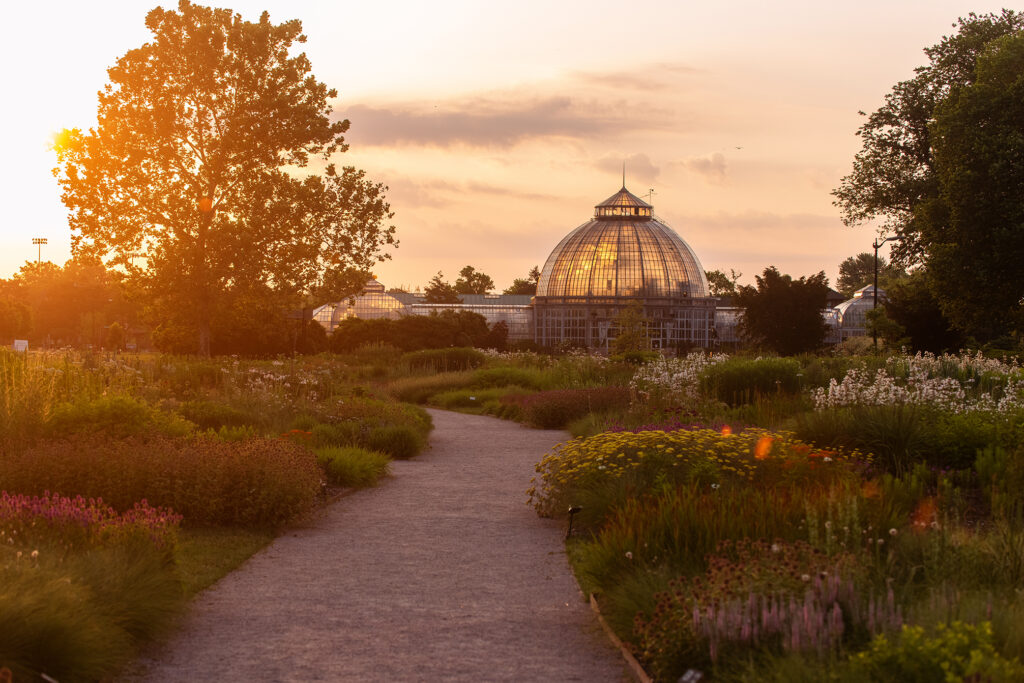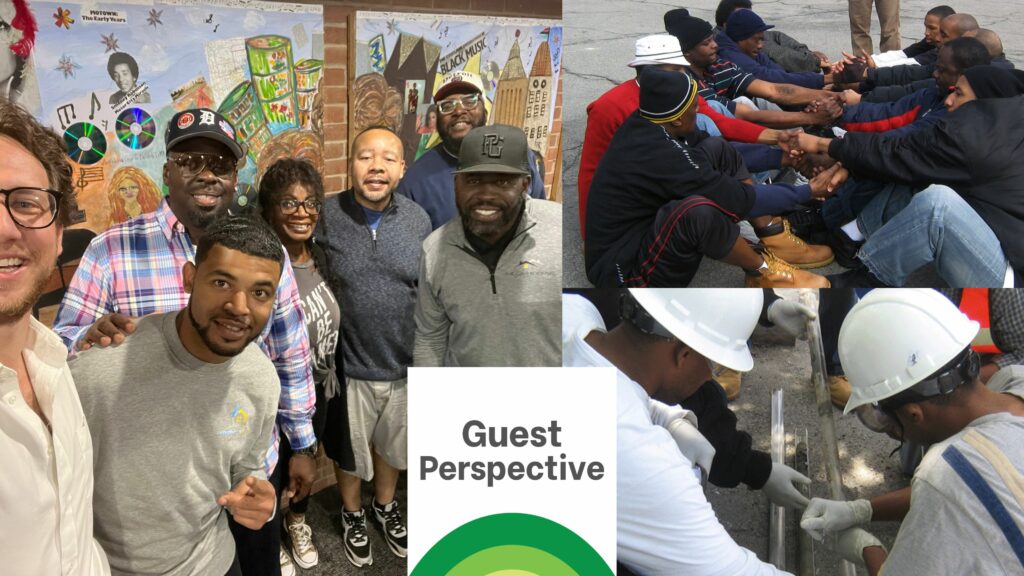New Leadership to Focus on Sustainability, Connectivity, Infrastructure

Meagan Elliott began her tenure as president and CEO of the Belle Isle Conservancy on July 1, following a decade with the city of Detroit, culminating in serving as chief parks planner and deputy CFO overseeing development and grants. Elliott spearheaded the Joe Louis Greenway Framework Plan and played a pivotal role as the city lead in a $350 million campaign for a unified greenway encompassing the Joe Louis Greenway and the Detroit Riverfront. The Belle Isle Conservancy is dedicated to safeguarding the natural environment, preserving historic structures, and enhancing Belle Isle as a public park for the enjoyment of all, now and in the future. According to the Michigan Department of Natural Resources, 5.6 million people visited the park last year. SBN Detroit interviewed Elliott about the conservancy’s approach to sustainability and what impacts her work will have on Southeast Michigan businesses and residents. Q: What part will sustainability play in your new role? A: Sustainability is fundamental to everything we do, and I want to lift and advance it in new ways. The Belle Isle Conservancy has done and continues to do a lot of work toward this. One example is the Keep Belle Isle Beautiful campaign focused on reducing plastic waste on the island and in waterways. That initiative has taken off and now goes far beyond the cleanups themselves, focusing on environmental stewardship and informing educational programming that helps to drive our future leaders. Caring for our planet forms the foundation of all our endeavors and is a filter for how we approach all our work, whether it be in support of habitat restoration, capital projects on the island, or new types of programming moving forward. I’m eager to collaborate with the Michigan Department of Natural Resources in this effort. Q: How does your background position you for this role? A: It’s in a couple of important ways. My tenure as chief parks planner was particularly formative, involving comprehensive work across all city green spaces, from neighborhood parks to a 30-mile greenway. When we consider Detroit’s park infrastructure, connectivity emerges as a fundamental concept. Historically, Belle Isle has been perceived as a separate entity and not easily accessible. Moreover, with one in four people in Detroit lacking access to a vehicle, they face challenges moving around the city, being able to access our amazing metro parks system, or getting Up North. Belle Isle is a treasure that rivals all of these spaces, and here it is right in our front yard. Connecting to a system of green space via the riverfront and the Joe Louis Greenway is essential. Connectedness extends beyond physical spaces to encompass the desires of residents and businesses surrounding Belle Isle as well. The Belle Isle Conservancy plays a crucial role as a steward and advocate, driving initiatives that reflect community wants and needs. Also, my background in sociology has prepared me to spend time listening to residents and how they want to utilize their island and to make sense of the patterns that emerge in engagement with a diversity of constituents. Finally, I’ve spent the last three years as deputy CFO brokering partnerships between private funders, philanthropic entities, and public partners and making initiatives happen by creating coalitions of folks. I want to put that same energy and investment behind Belle Isle. Q: You led the Joe Louis Greenway Framework Plan, and were the city lead in the $350 million campaign for a unified greenway for the Joe Louis Greenway and the Detroit Riverfront Conservancy. How will this impact your work going forward? A: I have an example. On my first day as president and CEO of the Belle Isle Conservancy, I was speaking at a press conference during which $20.7 million was received from the federal government for the continuing construction of the Joe Louis Greenway. This was a grant that the team worked on while I was still working for the City of Detroit. But I was there as the co-chair of the Joe Louis Greenway Partnership and was able to highlight the connection from the Joe Louis Greenway to the Iron Belle Trail, which ultimately will connect Belle Isle to Ironwood at the tip of the Upper Peninsula through a network of greenways. Many individuals have dedicated themselves to this work for a long time, and I’m committed to utilizing my platform and voice to continue to advance this work. Belle Isle is the epicenter of both this amazing network of green spaces and the Great Lakes. I can’t imagine a better geography for foregrounding environmental stewardship than on this island. Q: What impact do you think the Belle Isle Conservancy has on businesses in Southeast Michigan? A: I see the economic impact of public space as vast. It directly relates to employee decisions on where they choose to live and work. Belle Isle ranks as the second most visited park in the country after Niagara Falls. I believe our efforts here are directly linked to attracting new talent to businesses in Southeast Michigan and bolstering our economy. Q: In what way will you work with area businesses? A: The conservancy already does a lot of work with businesses on many fronts. One of the most immediately valuable impacts businesses have on Belle Isle is our corporate stewardship days. Businesses bring their teams to help clean up the park and connect with each other. We also have a significant number of partners in the corporate community who see the value of Belle Isle for the community and invest in projects to help support the park. We also have the opportunity to look at the vendors utilized on the island and how to create more inroads for Detroit-based businesses to play a role in the construction, management, concessionaire, and other vendor partnerships. There are endless opportunities to work together. Q: What challenges do you expect to encounter from a sustainability aspect? A: The challenge is always prioritization and how to choose projects and
Detroiters Working for Environmental Justice’s Vision for Sustainability

LAPRISHA BERRY DANIELS IS EXECUTIVE DIRECTOR OF DETROITERS WORKING FOR ENVIRONMENTAL JUSTICE AND A LEADERSHIP COMMITTEE MEMBER FOR SUSTAINABLE BUSINESS NETWORK DETROIT DWEJ’s vision for sustainability is rooted in the three pillars of sustainability: health and happiness of community members, a healthy local environment free from hazards and harm, and economic vitality. As an organization that focuses on environmental justice and strives to have the voice of the community-centered as decisions are being made that impact their health (physical, mental, spiritual, and economic), we assert that community members can envision and create healthy communities that meet their immediate and distal needs. A healthy community is one in which all systems work together to support the health and well-being of all its members. Local businesses are part of the community’s ecosystem and thus play a unique role in supporting the health and well-being of the community. Ideally, the relationship between community members and local business is mutually beneficial as they prioritize health and co-create a healthy community. Local businesses and community members can work together to identify threats to community well-being and create strategies to address challenges. In Detroit, and beyond, climate change threatens our ability to achieve and maintain physical, mental, spiritual, and economic health. As we experience more extreme weather locally, such as extreme heat and annual “100-year floods”, we recognize that our built environment may not be able to weather the storm (pun intended). Unfortunately, our existing residential housing stock and current construction practices are too often ill-suited for current and future climate conditions. The mismatch between what is available and what is needed creates threats to the health of people and planet. DWEJ developed a contractor accelerator program that focuses on contractors increasing their awareness about ways to improve the built environment to mitigate risks related to climate change while centering sustainability. DWEJ’s contractor accelerator program, Building Health, serves as an incubator to support peer-to-peer learning among Detroit-based, Detroit-serving contractors of color. Building Health increases contractors’ awareness and implementation of “environmentally responsible and resource-efficient” practices that have: Bottom-line business benefits Individual and community health benefits Decrease environmental degradation. Building Health increases contractors’ understanding of the impact they can have on health. For example, participating contractors are presented with strategies for upgrading and greening residential housing in ways that include the use of various building methods and materials that can make homes more energy efficient. These improvements decrease greenhouse gas emissions, improve the health and comfort of the home, and improve the economic health of the occupants by reducing the cost of utility use. Participants receive financial and technical assistance to implement practices as part of the program as well. Additionally, contractors learn how to best communicate the benefits of sustainable repair and rehab practices to clients. The role of local contractors is just one example of the opportunity our community has to transform our ecosystem and economy for the better. There is a unique and distinct role that local business plays in supporting people and planet. Sustainability is an iterative process where we must work collectively toward the goal of having healthy and vibrant places in which to live, learn, work, play, and pray. — Check out Laprisha Berry Daniels’s recent #TEDTalks: Lessons from the Past on Adapting to Climate Change Be sure to subscribe to our newsletter for regular updates on sustainable business practices in and around Detroit.


